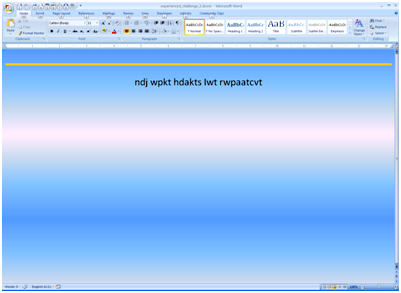Experienced Challenge 2: The Secret Word is FGJAJGSHSBSW
Office Programs Required |
Microsoft Word 2007 |
Goldfish Awarded |
10 |
Deadline for Submission |
Wednesday, April 22, 2009 (8:00 AM Pacific Daylight Time) |
Files Required |
Experienced_challenge_2.docm WordList.txt in the OfficePalooza Challenge Pack |
Every kid worth his or her salt knows how to make a secret code using letter substitution, a form of encoding in which one letter is used to represent another letter. In simple substitution, a letter is chosen to represent the letter A; for example, B will be used to represent the letter A. From that point on, each letter follows in turn: if A equals B, then B equals C, C equals D, D equals E, and so on. What if A equals X? No problem; in that case, B equals Y, C equals Z, and D equals A. (Having reached the end of the alphabet, we simply roll over and begin again with the first letter in the alphabet.) Here’s a partial example of a simple substitution cipher:
Letter |
Code Equivalent |
A |
E |
B |
F |
C |
G |
D |
H |
E |
I |
So how would you write the word BAD using this particular cipher? You got it: you’d use the letter F to represent the letter B; the letter E to represent the letter A; and the letter H to represent the letter D. Or, in other words:
FEH
As you can see, messages written with simple substitution ciphers are easy to encode. So are these ciphers equally easy to decode? In The Secret Word is FGJAJGSHSBSW, we’re about to find out.
To solve this challenge you first need to grab the file Experienced_challenge_2.docm, a file that can be found in the OfficePalooza Challenge Pack . The contents of Experienced_challenge_2.docm look a lot like this:

You say that looks like gobbledygook? That’s only because you haven’t deciphered the code. If you can figure out the letter substitution cipher we used, you’ll find out that this isn’t gobbledygook after all. Instead, these letters actually spell out – well, that’s for us to know, and for you to find out.
Important. Actually, this is more gobbledygooked than we expected: somehow or another we allowed an uppercase I to appear in our encoded message. All the letters -- including the I in iwt should be lowercase. Just treat all the letters as lowercase and you should be fine. Also, please make sure that your subroutine verifies that all the words you come up with can be found in the file WordList.txt. Your code must do this in order for you to get credit for solving this challenge.
To that end, you need to modify the macro we named Decode; at the moment, that macro looks like this:
Sub Decode()
'
' Decode Macro
'
'
End Sub
Granted, it doesn’t look like much now, but that’s the whole idea: it’s your job to add the Visual Basic for Applications (VBA) code that can figure out the letter substitution cipher we used to encode our secret message. Before you begin your decoding quest, here are some points to keep in mind:
· We’ve used only lowercase letters in our message; no numbers, no punctuation, and no special characters. You only have to worry about the letters a through z.
· Any blank spaces you see in the secret message should also be blank spaces in the decoded message. We’ve encoded the words in the message but not the blank spaces.
· All the words in the secret message can be found in the file WordList.txt, which is also available in the Challenge Pack. How do you know if you’ve successfully solved the challenge? Well, if all the words your macro derives can be found in WordList.txt then there’s a good chance you’ve solved the challenge.
· We’ve used the same substitution pattern throughout. For example, suppose we decide to use the letter b in place of the letter a. That would mean we would use c for b, d for c, and on through a standing in for the letter z. See how that works?
If you have any problems decoding this secret message, send email to palooza@microsoft.com. Either that, or find a kid worth his or her salt and ask them for help.
Submitting Your Entry
The OfficePalooza sweepstakes is over, but you’re welcome to try the challenges and learn on your own. Good luck!